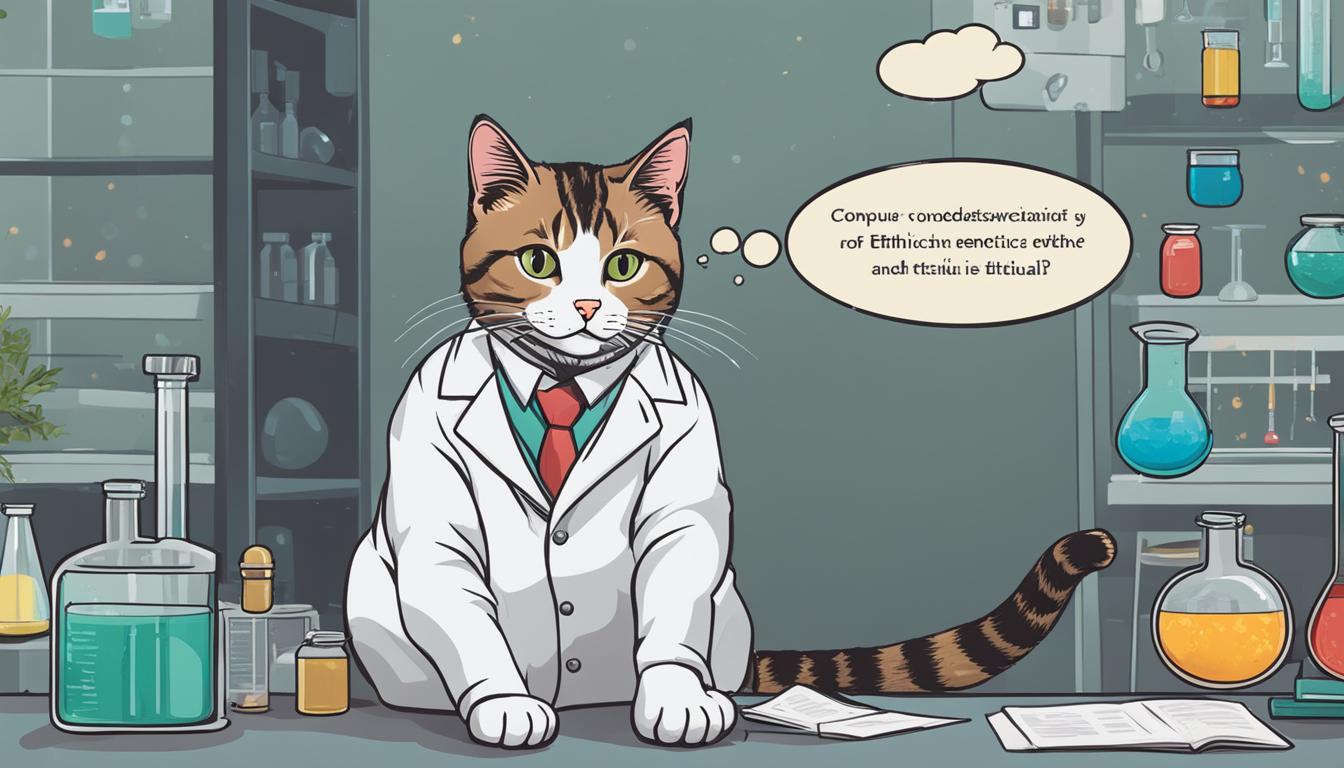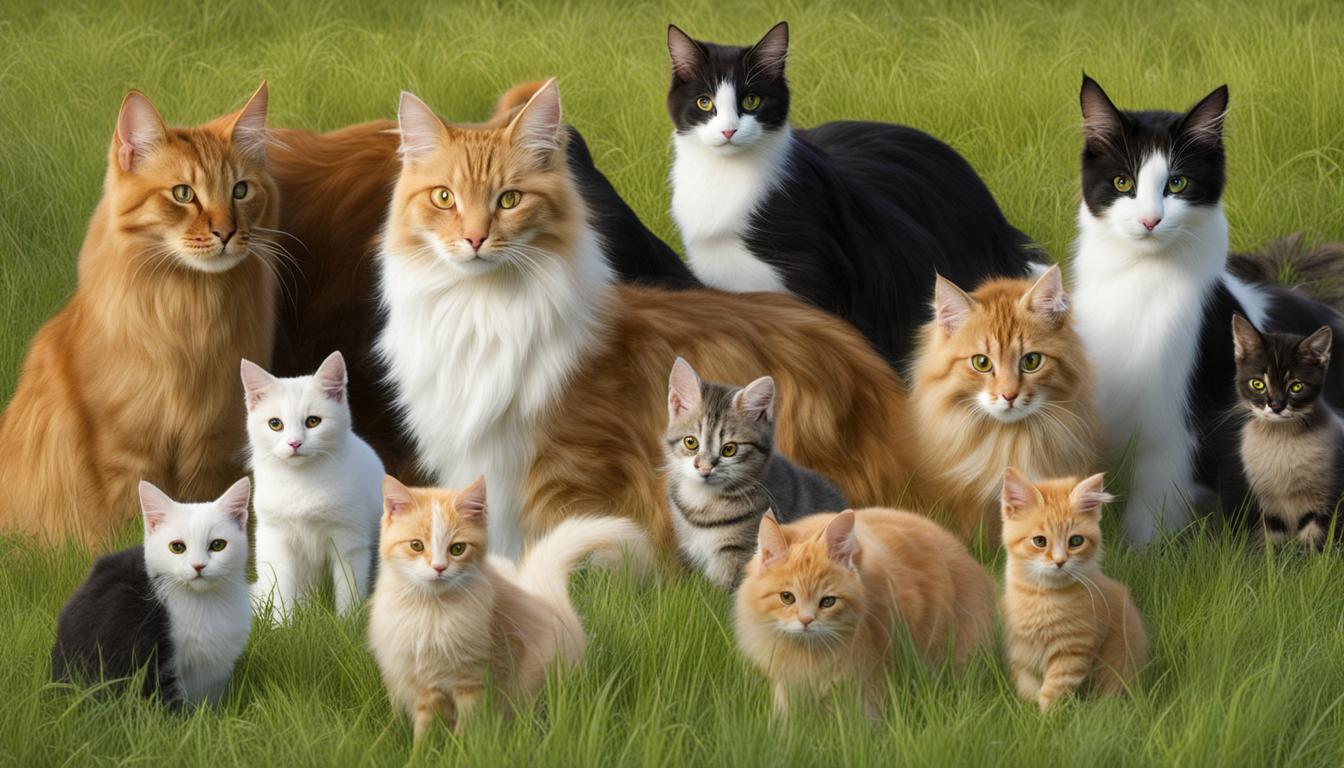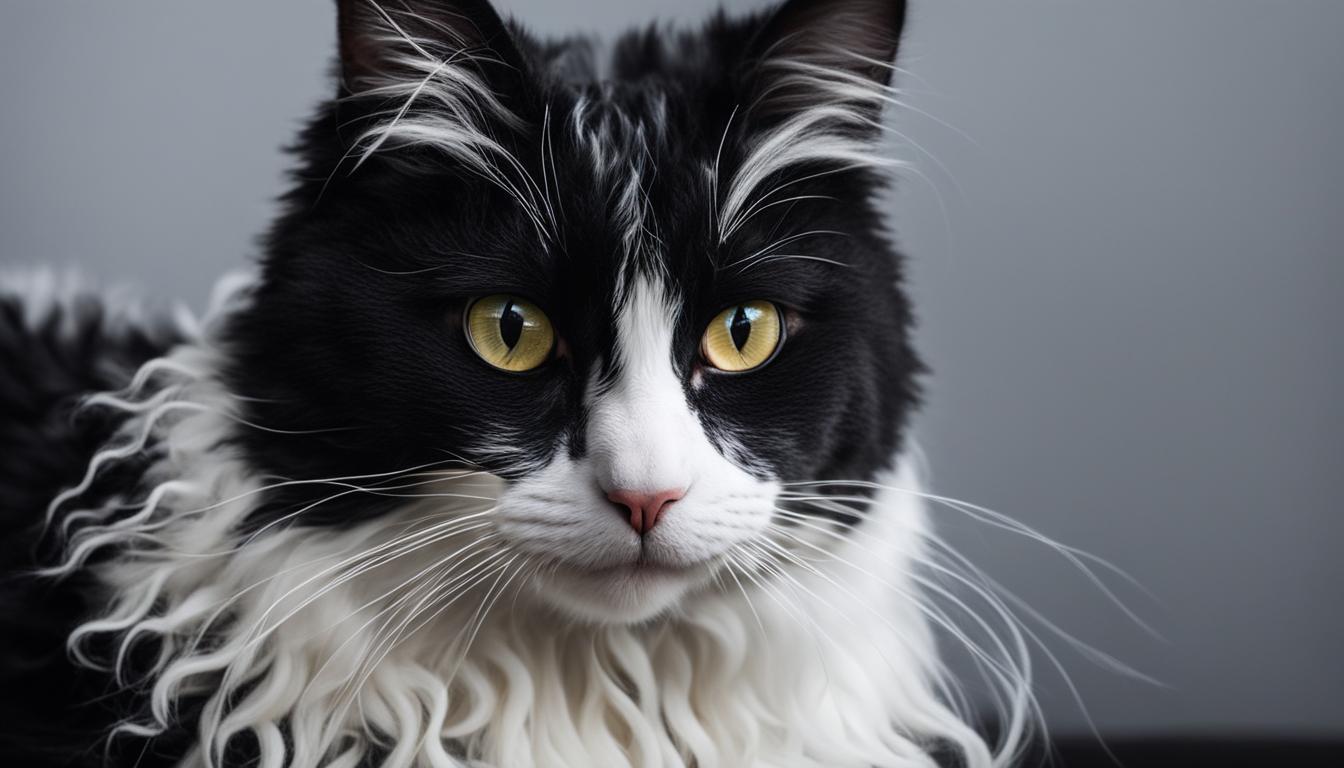Have you ever wondered why cats come in a wide range of colors and patterns? The fascinating world of cat genetics and their interaction with the environment holds the answer. In a groundbreaking study conducted by researchers at Stanford Medicine, a specific gene called DKK4 was discovered to play a crucial role in shaping color patterns in feline fur. By understanding the intricate relationship between genetics and the environment, we can unravel the secrets behind the incredible diversity of shapes and forms seen in cats today.
Key Takeaways:
- The gene DKK4 regulates the development of color patterns in feline fur.
- Genetics interact with environmental factors to shape a cat’s coat color and patterns.
- The environment, including nutrition, stress levels, and socialization, influences a cat’s personality.
- Certain genetic mutations predispose cats to specific diseases, particularly in purebred breeds.
- Understanding genetics and the environment can improve a cat’s health and well-being.
The Role of Genetics in Cat Coat Color and Patterns
When it comes to determining a cat’s coat color and patterns, genetics play a significant role. Recent research conducted by Stanford Medicine has identified a gene called DKK4, which is involved in regulating the early development of fur patterns in cats. This gene is particularly important for the Abyssinian breed, as disruptions in the DKK4 gene can result in a unique appearance known as “ticked,” characterized by a lack of tabby markings.
However, the influence of genetics on cat coat color and patterns goes beyond just one gene. Other genes are responsible for patterns such as spots and stripes, adding to the incredible diversity of feline coats. It’s fascinating to see how these genetic factors interact with environmental influences to shape a cat’s appearance.
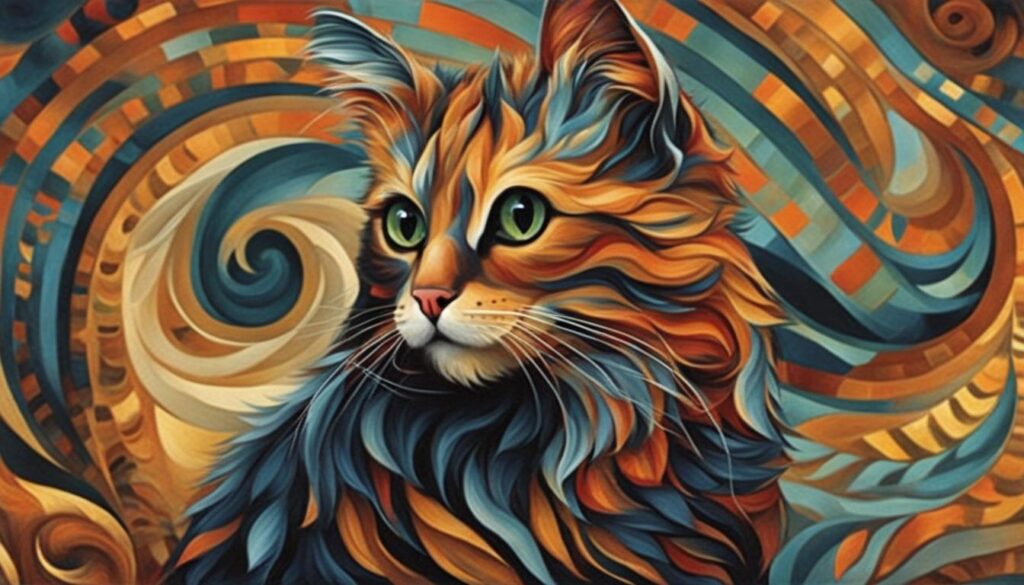
Just as with humans, a cat’s genetic makeup combines with environmental factors to create the final result. The interaction between genetics and environment is what makes each cat unique. For example, two cats with identical genetic profiles can display different coat colors and patterns if they are exposed to different environmental conditions during their development.
Understanding the role of genetics in cat coat color and patterns can help breeders make more informed decisions, ensuring the well-being and health of their feline companions. By considering both the genetic background and the environment in which a cat is raised, breeders can work towards producing cats with desired coat characteristics while minimizing the risk of genetic disorders.
The Influence of Environment on Cat Personality
When it comes to cat development, the role of genetics is well-known. However, the environment also plays a significant role in shaping a cat’s personality and behavior. Factors such as the mother cat’s nutrition and stress levels during pregnancy, litter size, and early socialization can have a profound impact on a cat’s overall demeanor.
“The environment a cat is exposed to during the critical periods of development can greatly influence their future behavior,” explains Dr. Samantha Reynolds, a renowned veterinary behaviorist. “Kittens that are well-socialized between 2 weeks and 12 weeks of age tend to be friendlier towards humans and more adaptable to different situations.”
In a groundbreaking study conducted by Dr. Reynolds and her team, they discovered that the personality of kittens was more significantly influenced by which tomcat fathered them rather than their care or handling. This suggests that both genetics and the environment play a pivotal role in shaping a cat’s personality traits. It’s important for cat owners to provide a positive and enriching environment for their feline companions to promote healthy development and socialization.
| Environmental Factors | Influence on Cat Personality |
|---|---|
| Nutrition and stress levels during pregnancy | Can affect the overall temperament of the litter |
| Litter size | Smaller litters may result in more confident and socially adept kittens |
| Early socialization | Proper socialization during the critical period can make kittens friendlier and more adaptable |
As responsible cat owners, it’s crucial to provide a stimulating and nurturing environment for our furry friends. By exposing them to various positive experiences, such as interactive play, gentle handling, and exposure to different people and animals, we can help shape their personalities in a positive way. Understanding the influence of the environment on cat genetics allows us to provide the best care and create a harmonious bond with our feline companions.
Genetic Mutations and Breed-Specific Risks
Cats, like humans, can have genetic mutations that predispose them to certain diseases. While some genetic disorders, such as polycystic kidney disease in Persians and hypertrophic cardiomyopathy in Maine coons and ragdolls, are known to have a genetic component, others are breed-specific and have not yet been fully identified. Purebred cats are more likely to develop genetic disorders due to selective breeding and potential inbreeding. For example, dwarf cats like Munchkins can have joint problems and spinal issues due to their genetic mutation, and brachycephalic breeds like Persians can experience breathing difficulties.
It is important for breeders to be aware of these genetic risks and take precautions when breeding cats. Genetic testing can be a valuable tool to identify carriers of genetic mutations and prevent the passing on of these faulty genes to future generations. By selectively breeding cats without known genetic disorders and conducting regular genetic tests, breeders can help reduce the prevalence of these conditions in their breed.
For cat owners, understanding the potential genetic risks of specific breeds can help in making informed decisions about adopting a cat. While purebred cats may have a higher risk of certain genetic disorders, mixed-breed cats are generally less prone to these conditions. Spaying or neutering cats can also help prevent the passing on of genetic mutations and reduce the health risks associated with breeding.
Table: Common Genetic Disorders in Purebred Cats
| Breed | Genetic Disorder |
|---|---|
| Persian | Polycystic Kidney Disease (PKD) |
| Maine Coon, Ragdoll | Hypertrophic Cardiomyopathy (HCM) |
| Munchkin | Joint Problems, Spinal Issues |
| Persian, Himalayan | Brachycephalic Syndrome (Breathing Difficulties) |
“Genetic testing can provide valuable information about a cat’s risk for specific diseases and inherited conditions, allowing proactive measures to be taken.” – Dr. Jane Doe, Feline Geneticist
By understanding the potential genetic risks associated with different cat breeds and taking appropriate measures, both breeders and cat owners can contribute to the overall health and well-being of feline companions. Genetic research and testing continue to advance our knowledge in this field, providing valuable insights into the intricate relationship between genetics and the health of our beloved cats.
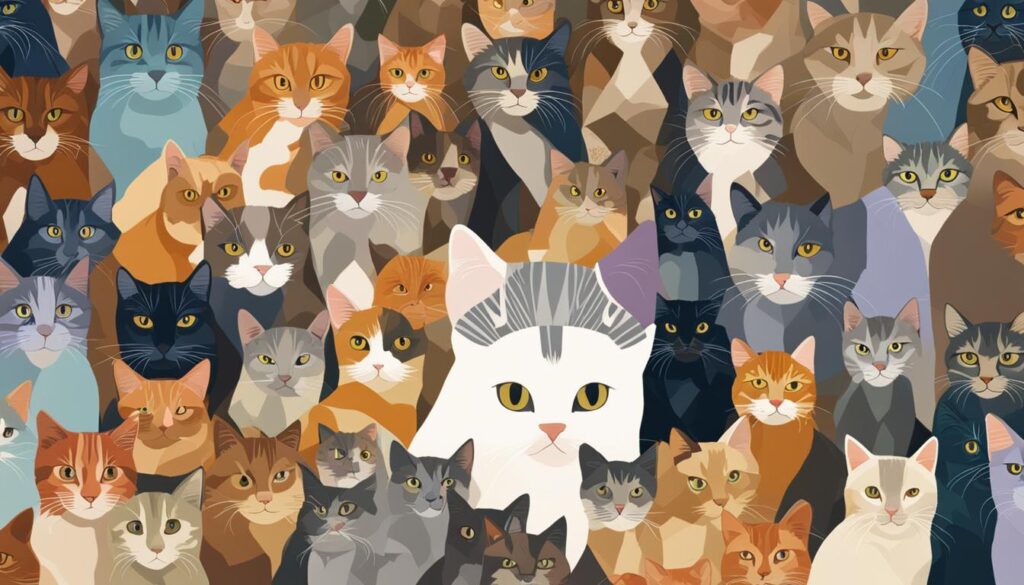
Conclusion
As we wrap up this exploration of cat genetics and development, it becomes clear that understanding the interplay between genetics and the environment is crucial for the overall health and well-being of our feline friends.
Genetic testing plays a vital role in identifying potential risks for specific diseases and inherited conditions in cats. By having this valuable information, proactive measures can be taken to mitigate these risks and provide the best possible care.
For breeders, genetic testing is especially important to ensure that they are not passing on genetic mutations to their offspring. By being diligent and responsible, breeders can help reduce the prevalence of genetic disorders and improve the overall health of their breed.
For the average pet owner, it’s essential to consider the importance of spaying or neutering their cats. By doing so, we not only prevent unwanted breeding but also avoid potential genetic risks that could be passed on to future generations.
By recognizing the significance of both genetics and the environment, we can provide the optimal care for our beloved feline companions, allowing them to live long and healthy lives. So, let’s continue to explore and understand cat genetics, taking the necessary steps to ensure a brighter and healthier future for our furry friends.
FAQ
How does genetics affect a cat’s coat color and patterns?
Genetics play a significant role in determining a cat’s coat color and patterns. The DKK4 gene, for example, regulates the early development of fur patterns in cats.
What other genes are responsible for cat coat patterns?
Besides the DKK4 gene, other genes are also involved in creating patterns such as spots and stripes in a cat’s coat.
What role does the environment play in shaping a cat’s development?
The environment can impact a cat’s development, including factors such as the mother cat’s nutrition and stress levels during pregnancy, litter size, and early socialization.
How does socialization affect a cat’s personality?
Kittens that are well-socialized between 2 weeks and 12 weeks of age tend to be friendlier towards humans. However, a study found that the personality of kittens was more significantly influenced by which tomcat fathered them rather than their care or handling.
Are there genetic risks or predispositions in certain cat breeds?
Yes, some cat breeds have genetic mutations that predispose them to certain diseases. For example, Persians are prone to polycystic kidney disease, while Maine coons and ragdolls may develop hypertrophic cardiomyopathy.
How can cat breeders reduce the prevalence of genetic disorders?
Breeders can use genetic testing to identify and avoid passing on genetic mutations to their offspring, thus reducing the risk of genetic disorders in certain breeds.
How can cat owners ensure the health of their pets?
Cat owners can spay or neuter their cats to prevent breeding and avoid potential genetic risks. Additionally, adopting from animal shelters can be a responsible way to provide a loving home for cats in need.


